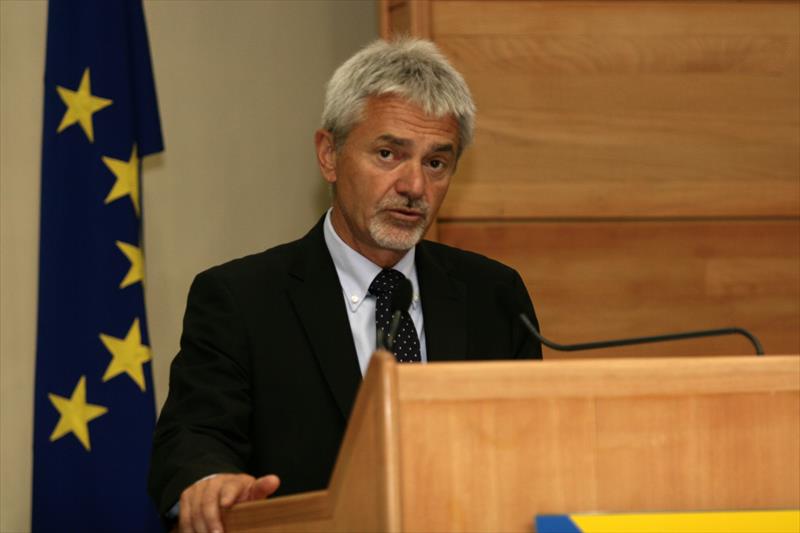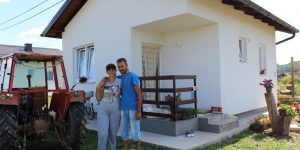What has been done and how much was done in assisting people affected by thefloods in BiH?
The EU has stood by BiH and will continue to do so. In the immediate aftermath of the floods, the EU provided humanitarian assistance to the victims, and hosted the international donor conference in July 2014 in which 810 million EUR was pledged to BiH specifically.
Right now, the main European Unionsupport to the flood victims in BiH is the EU Floods Recovery Programme, which was launched in August 2014 and which will be implemented until October 2015. The total value of the programme is 43.52 million EUR, out of which the EU finances 42.24 million EUR (the remaining amount is co-funded by the implementing partner, UNDP).
The Programme consists of different components all of which aim to assist with the normalisation of peoples’ lives in flood-affected areas and communities in the 24 most affected communities. The activities focus on the immediate restoration of vital public sector infrastructure and reinstatement of key public services, the emergency reconstruction of private dwellings for the most vulnerable and marginalised people, and the revitalisation of local economy and agriculture production.
Overall, the EU-funded Programme targets the rehabilitation of a total of 4,221 objects, out of which:
• 4,000 are private dwellings for the most vulnerable and marginalised people affected by the floods;
• 90 are schools and kindergartens;
• 3 are municipal administration buildings;
• 4 are healthcare care centres;
• 4 are social welfare centres;
• 100 are communal roads and bridges; and
• 10 are water and sanitation facilities.
In addition, the EU is financing the retention and generation of up to 2,000 jobs in small and medium-sized enterprises (SMEs), including in the agriculture sector.
All programme components are active now with schools at the top of the list to minimise disruptions to the school year.
In terms of state of play, in totalmore than 10 million EUR have already been committed to rehabilitation and reconstruction works in the first 50 days of the Programme. By the end of this week (10 October), 34 objects have beencompleted and made operational (29schools, 3 kindergartens, 1 health care centre and 1 social welfare centre). So far, the Programme has benefitted more than 15,000 pupils and students directly in the above mentioned 29rehabilitated schools.
Another 17 public facilities from the first group of 50 objects that were identified for urgent rehabilitation are expected tobe finalised in the course of October. This includes the rest of the heavily damaged schools with the exception of four schools which have suffered extensive damage and hence need to be rebuilt from the ground.
Rehabilitation of another 40 public facilities with EU financing is expected to be completed until the end of the year. These includes healthcare centres, municipal administrative headquarters and centres for social welfare.
The implementation of emergency housing rehabilitation is now underway. Works are already ongoing in more than 300 priority dwellings targeting the most vulnerable people affected by the floods, and rehabilitation works on some 30 dwellings have been finalised by now. A further 300 priority dwellings are under selection process at the moment, which brings the total number of households receiving priority rehabilitation support to around 650.
The deadline for the firstpublic call for identification of further 1,200 beneficiariesexpired on October 7, 2014. The second public call for housing support will be launched in the course of next week in selected eligible municipalities. Overall, the programme will directly assist around 14,000 people to return home through rehabilitation of private dwellings.
As for activities focusing on economic recovery, the EU is working on employment retention and generation through targeted assistance to affected small and medium-sized enterprises (SMEs). A total of 460 small and medium-sized enterprises (SMEs) wishing to benefit from EU assistance in restoring their productive capacities have applied for grants under the EU Floods Recovery Programme until the application deadline (which expired on October 1), and we expect to finalise the selection process and the list of beneficiaries around 15 October 2014.
In addition, works are ongoing on20 priority communal infrastructure projects, targeting communities that were cut off from basic services due to floods and landslides which damaged local roads and bridges. A total of 30 local roads and bridges are expected to be finalised by the end of the year.
Could you tell us a bit more about the EU projects in this regard?
In addition to the Floods Recovery Programme, the EU finances several other separate activities which aim to support in the recovery process. These include immediate support for emergency mine clearance operations through several non-governmental organisations in four municipalities. Awareness-raising activities related to mine hazardshave also been implemented in the Posavina Canton. Recovery works focusing on river banks have been enabled, including supporting the BiH authorities in developing measures for strengthened on river management and flood protection.
The EU is providing around 80 grants (comprising non-food items, cleaning materials, appliances etc.) for flood-affected Roma families in four municipalities. This was done under the EU-funded Roma Action Plan project. The EU’s ongoing Social Housing Project assists some 10 families that lost their homes due to the floods and landslides through provision of durable housing solutions in Tuzla, Bijeljina and Brcko.
The EU will be rehabilitating the judicial institutions in Doboj(comprising three courts and a prosecutor’s office). In addition to repairing the flood damage, the EU funding also aimsto strengthen judicial efficiency, including improving the design of the judicial space.
As for future support, the EU intends to allocate approximately 43 million EUR under IPA II for continued and further actions for floods recovery and prevention, upon the ratification of the Framework Agreement by the BiH authorities.
On the regional level, the EU has earmarked approximately 24 million EUR for the same purpose for regional cooperation, to support BiH and Serbia in their joint endeavours for flood recovery and prevention.
How would you evaluate the relations of the state vis-à-vis this problem?
We coordinate our operations and collaborate closely with the relevant BiHauthorises on different levels. The EU-funded Programme is addressing the rehabilitation needs based on the priorities identified jointly with theauthorities, including entity, cantonal and municipal level representatives. While the majority of the activities financed by the EU are focusing on the 24 most affected municipalities, assistance is being extended also those municipalities which have suffered less devastation. This is primarily the case for communal infrastructure projects where the call to nominate objects for rehabilitation was sent to all municipalities that reported flood-related damages.
Local authorities play an important role in beneficiary selection for housing assistancebased on the proposals received through the public call. The beneficiaries will be selected by local commissions where local authorities will be represented.Local authorities also play a key role in coordinating efforts by individual donors to minimise overlap and ensure synergies, where available.
In order to expedite the implementation of donors’ pledges and to improve state-level aid coordination, BiH needs to develop common allocation criteria (i.e. a State Recovery Plan) to ensure efficient, equitable and transparent use of funds. Coordination issues were discussed in the first meeting of the Programme Advisory Panel with relevant state, entity and Brcko District authorities on October 8, and we look forward to further discussions at the Donor Coordination Forum meeting on October 16, organised by the Ministry of Finance and Treasury.
What is the situation on the field looks like? Where was the biggest progressnoted, and where is the situation still difficult?
We are pleased with the progress and results achieved thus far under the EU’s Floods Recovery Programme, with rehabilitation of 34public facilities already finalised. However, implementation challenges remain; the weather has obviously not been an ally and continuous rainshave caused a number of delays in the works.
We should remember however that the ongoing EU-funded Programme focuses on immediate priorities in the affected areas, which first and foremost aims to enable communities to normalise their living conditions, allow the restoration of essential services and provide support to the most vulnerable and marginalised in terms of housing rehabilitation.
Much more will need to be done in the affected communities to support them in the reconstruction process. In addition to repairing the damages caused by the May 2014 floods, it needs to be noted that increased efforts are required to strengthen flood resilience and disaster risk reduction in flood-prone areas, and to protect the newly rehabilitated schools and other public facilities – asthe threat of re-flooding is ever present.
Do you have any message which would encourage people who are expecting wintertime with uncertainty?
The EUremains committed to support the flood-affected communities and we have acted swiftly to help the people to return to their normal lives. We are working hard to make a difference and despite challenges, results are being delivered. We hope to achieve much more in the coming 12 months while the EU Programme is ongoing.
I know that a lot of people, ordinary citizens, have been reaching out and helping their neighbours and friends. We have seen the best of BiH and I hope this spirit continues. We are urging the BiH authorities to act as quickly as they can, too.
We encourage everyone eligible to apply for support through the Programme’s public calls. The second public call for housing rehabilitation support will be released in the course of next week, targeting damaged dwellings in Tuzla, Sanski Most, Živinice, Zenica, Banja Luka, Prijedor, Modriča and Laktaši. Full details and information on how to apply can be found on the EU Delegation to BiH website (www.europa.ba.) and the UNDP in BiH website (www.undp.ba) and in local media upon the publication of the call.
All theseactions, coming directly from the citizens of the EU, are a strong signal of solidarity and we will continue to look at other ways to help in the future, including in the context of IPA 2 funds.
It is clear, however, that a huge work remains to be done to fully repair the damages caused by the floods and to avoid such catastrophes in the future by strengthening flood resilience. It’s a key challenge for the BiH authorities in the months ahead. We are doing our utmost to be an active partner to them and to the communities of BiH. In the end this must be a collective effort in which everyone must play their part.




